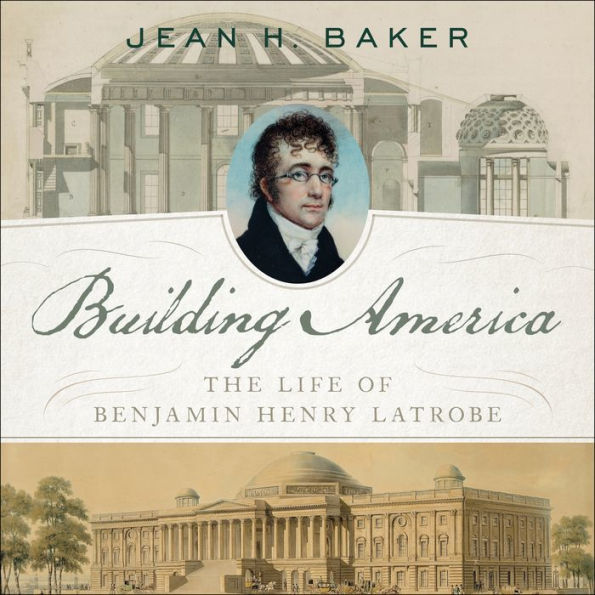"Latrobe's work as an architect and designer had an indelible effect on the nation. And because of Baker's painstaking reconstruction of his life, we now know much more about the character behind those visions....Baker is at her best when she balances her attention on Latrobe's eccentricities with her scrutiny of the symbolic significance and design brilliance of some of his great achievements....Building America will be of great use to scholars tracing those important connections between public works and design, especially in its attention to the leading characters who fought among themselves to realize early national fantasies. By paying such close attention to Latrobe, Baker reveals a much more tangled and often-contradictory story of the early decades of the United States." — Carolyn Eastman, Journal of American History
"Both Benjamin Latrobe and his biographer Jean H. Baker will be remembered for their roles in "building America," one for his lasting contributions to architecture and engineering, the other for her mastery of readable and lasting biography." — Edward C. Papenfuse, Maryland Historical Magazine"An absorbing narrative of a prominent contributor to the architecture of the American way of life....Both Benjamin Latrobe and his biographer Jean H. Baker will be remembered for their roles in 'building America,' one for his lasting contributions to architecture and engineering, the other for her mastery of readable and lasting biography." — Edward C. Papenfuse, Maryland Historical Magazine"In an engaging and readable style...Jean Baker ably presents the often-overlooked story of America's first professional architect and engineer....Baker has given us an engaging portrait of a complex man, one who played a pivotal role in literally building the United States in its critical early years." — Jeanne Abrams, Journal of the History of Medicine and Allied Sciences"This book should succeed Talbot Hamlin's Pulitzer Prize-winning doorstopper, Benjamin Henry Latrobe: Architect, Artist, Engineer (1955), as the definitive biography....Baker puts Latrobe's flaws, and his more endearing qualities as a father and husband, under the socially astute modern historian's microscope. The man said to be America's first architect and engineer (though many others performed those services at the time) is given credit for proclaiming that architecture was a sovereign profession—one that couldn't be trusted to mere 'mechanics'—that required training and deserved fair compensation....His legacy is one of an uncompromising and long-suffering champion for his profession and its vision and stewardship of the built environment." — Richard Korman, Architectural Digest"Architecture, it has been said, is first shaped by human beings, and then shapes those human beings. In this lucid and important book, Jean H. Baker tells the engaging story of Benjamin Henry Latrobe, the man whose buildings and designs have left an indelible and enduring mark on the American nation."-Jon Meacham, author of The Soul of America"As America's first great architect and engineer, Benjamin Henry Latrobe transferred the founders' vision of the nation to its buildings-from homes to churches, banks, municipal waterworks, and the US Capitol. Jean Baker does an admirable job of revealing the man behind the monuments."-Donald A. Ritchie, Senate Historian Emeritus "Setting his life against the backdrop of the vast opportunities in the new American republic, Jean Baker gives us a compelling portrait of the frequently brilliant, often mercurial, and deeply proud architect and engineer Benjamin Henry Latrobe."-Darwin H. Stapleton, editor of The Engineering Drawings of Benjamin Henry Latrobe "The life of Benjamin Latrobe as told by Jean Baker adds a unique human story to the cast of characters who built the American Republic. A peer and friend of Jefferson, an admirer of Tom Paine, and the architect of the nation's Capitol, Latrobe was no homespun American like Ben Franklin. Despite his aristocratic airs, repeated financial blunders, and chronic headaches, Latrobe managed to build the domed monuments that sheltered and symbolized the infant republic."-Mary Ryan, author of Taking the Land to Make the City: A Bicoastal History"To students of the early American republic, Benjamin Henry Latrobe looms large-he brilliantly undertook some of the most notable architectural commissions of the day, including the U.S. Capitol, the Baltimore Cathedral, the Bank of Pennsylvania, and other fine buildings. In this book, Jean H. Baker critically reviews the multitudes of documents and letters Latrobe left behind and evaluates both the professional successes that ensured his national legacy and the personal flaws that led to financial ruin. With this fresh look at Latrobe's life in the Old World and the New, Baker provides us with a compelling human story and solidifies her status as among the nation's most accomplished historians."-Antoinette J. Lee, author of Architects to the Nation: The Rise and Decline of the Supervising Architect's Office"[An] insightful portrait of the early republic's greatest architect... A fluid, much-needed biography of a remarkable man."—Kirkus "With this fine biography, historian Baker rescues Benjamin Henry Latrobe from obscurity and restores his reputation as the 'Father of American Architecture.'"—National Book Review



